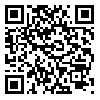BibTeX | RIS | EndNote | Medlars | ProCite | Reference Manager | RefWorks
Send citation to:
URL: http://nbr.khu.ac.ir/article-1-2685-en.html
Main agent orange-red coloured pigment of henna is a molecule called Lawson which is responsible for anti-microbial, anti-tumor, anti-inflammatory and analgesic activity. Chitosan is a biopolymer with high strength, biocom-patibility and biodegradability, non-toxicity and antimicrobial properties. Electrospinning is a method of producing su-bmicron polymeric fibers with high porosity and high surface/volume ratio. In this study, electrospinning of chitos-an/polyethylene oxide (Chit/PEO) nanofibers with the addition of henna extract to create nanofibers with antimicrobial properties were examined. Nanofibers was constructed by electrospinning of polymeric solution with proper size and si-ze distribution of Chit/PEO with a ratio 90/10. Then, Lawsonia inermis (henna) extract as an additive to Chit/PEO co-polymer was added and electrospined on the surface. After characterization of nanofibers using SEM, the antimicrobial properties of polymeric solution and nanofibers were investigated. The scanning electron micrographs showed that Ch-it/PEO nanofibres with a low percentage of henna extract have suitable diameters and size distribution similar to Ch-it/PEO nanofibres without adding extract. In bacteriological studies, it was found that chitosan polymer solutions cont-aining 1% of henna extract has bactericidal properties against Staphylococcus aureus, Escherichia coli and Pseudo-monas aeruginosa bacteries better than polymer chitosan solution without adding the extract.
Received: 2015/11/8 | Revised: 2017/05/12 | Accepted: 2016/06/13 | Published: 2016/12/5 | ePublished: 2016/12/5
| Rights and permissions | |
 |
This work is licensed under a Creative Commons Attribution-NonCommercial 4.0 International License. |







